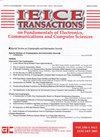Hilbert series for systems of UOV polynomials
IF 0.4
4区 计算机科学
Q4 COMPUTER SCIENCE, HARDWARE & ARCHITECTURE
Ieice Transactions on Fundamentals of Electronics Communications and Computer Sciences
Pub Date : 2023-01-01
DOI:10.1587/transfun.2023cip0019
引用次数: 1
Abstract
Multivariate public key cryptosystems (MPKC) are constructed based on the problem of solving multivariate quadratic equations (MQ problem). Among various multivariate schemes, UOV is an important signature scheme since it is underlying some signature schemes such as MAYO, QR-UOV, and Rainbow which was a finalist of NIST PQC standardization project. To analyze the security of a multivariate scheme, it is necessary to analyze the first fall degree or solving degree for the system of polynomial equations used in specific attacks. It is known that the first fall degree or solving degree often relates to the Hilbert series of the ideal generated by the system. In this paper, we study the Hilbert series of the UOV scheme, and more specifically, we study the Hilbert series of ideals generated by quadratic polynomials used in the central map of UOV. In particular, we derive a prediction formula of the Hilbert series by using some experimental results. Moreover, we apply it to the analysis of the reconciliation attack for MAYO.UOV多项式系统的Hilbert级数
多变量公钥密码系统(MPKC)是基于求解多变量二次方程问题(MQ问题)构造的。在各种多变量签名方案中,UOV是一个重要的签名方案,它是MAYO、QR-UOV和Rainbow等签名方案的基础,后者已入围NIST PQC标准化项目。为了分析多变量方案的安全性,需要分析特定攻击中使用的多项式方程组的首降度或解度。我们知道,一阶降度或解度往往与系统所产生的理想的希尔伯特级数有关。本文研究了UOV格式的Hilbert级数,更具体地说,我们研究了UOV中心映射中使用的二次多项式生成的理想的Hilbert级数。特别地,我们利用一些实验结果推导出了希尔伯特级数的预测公式。此外,我们还将其应用于MAYO的调和攻击分析。
本文章由计算机程序翻译,如有差异,请以英文原文为准。
求助全文
约1分钟内获得全文
求助全文
来源期刊

CiteScore
1.10
自引率
20.00%
发文量
137
审稿时长
3.9 months
期刊介绍:
Includes reports on research, developments, and examinations performed by the Society''s members for the specific fields shown in the category list such as detailed below, the contents of which may advance the development of science and industry:
(1) Reports on new theories, experiments with new contents, or extensions of and supplements to conventional theories and experiments.
(2) Reports on development of measurement technology and various applied technologies.
(3) Reports on the planning, design, manufacture, testing, or operation of facilities, machinery, parts, materials, etc.
(4) Presentation of new methods, suggestion of new angles, ideas, systematization, software, or any new facts regarding the above.
 求助内容:
求助内容: 应助结果提醒方式:
应助结果提醒方式:


